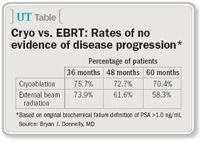Article
Cryo, EBRT have comparable outcomes in prostate Ca
After nearly 7 years of follow-up, cryoablation appears to be as effective as external beam radiation therapy (EBRT) in the treatment of localized prostate cancer, according to the results of a prospective, randomized trial.
Anaheim, CA-After nearly 7 years of follow-up, cryoablation appears to be as effective as external beam radiation therapy (EBRT) in the treatment of localized prostate cancer, according to the results of a prospective, randomized trial undertaken by researchers at the University of Calgary, Alberta, Canada.

The two treatment groups were similar in their baseline demographics and disease characteristics.
"Controversy continues over what constitutes optimal treatment for localized prostate cancer as there remains a conspicuous lack of randomized trials directly comparing different modalities," said lead author Bryan J. Donnelly, MD, assistant clinical professor of urology and chair of the University of Calgary's Prostate Cancer Institute. "Our experience with accrual underlines that such head-to-head studies are difficult, but can be done, and the results from this study to date suggest cryoablation and EBRT can be considered similarly effective."
Men were eligible for the study if they had T1-3, Nx, M0 disease and a baseline PSA <20.0 ng/mL. After being stratified by stage, Gleason score, and baseline PSA, the men were randomized 1:1 to EBRT or cryoablation. All patients received neoadjuvant hormonal therapy.
The primary endpoint of no evidence of disease progression is being calculated with two different criteria for defining biochemical failure: an original protocol definition of two consecutive rises in PSA with the last value being >1.0 ng/mL, and the new American Society for Therapeutic Radiology and Oncology definition of nadir plus 2.0 ng/mL.
Based on the protocol definition of biochemical failure, the rates of no evidence of disease progression in the cryoablation and EBRT groups were 75.7% versus 73.9% at 36 months (difference, –1.8%; 95% CI: –13.4% to 9.8%), 72.7% versus 61.6% at 48 months (–11.1%; 95% CI: –24% to 1.8%), and 70.4% versus 58.3% at 60 months (–12.1%; 95% CI: –25.6% to 1.4%). Corresponding rates for both groups at all follow-ups are higher using the new ASTRO definition. At 60 months, the rates of no evidence of disease progression are 78.2% for the cryoablation group and 72.6% for the EBRT group (difference, –5.6%; 95% CI: -17.7% to 6.5%).
Limited by definition
"One of the limitations of this study is that it uses surrogate endpoints, which continues to be problematic because no validated surrogate endpoint exists and the definition of biochemical failure changes over time. Given the controversy in this area, we chose to analyze our results using two separate definitions," Dr. Donnelly told Urology Times.














